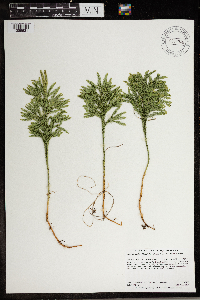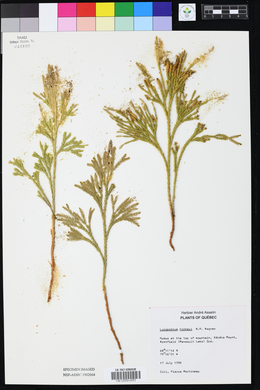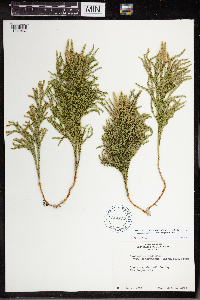Dendrolycopodium hickeyi
|
|
|
|
Family: Lycopodiaceae
Pennsylvania Tree-Club-Moss
[Lycopodium hickeyi W.H. Wagner, Beitel & Moran, moreLycopodium obscurum var. isophyllum Hickey] |
Horizontal stems subterranean. Upright shoots treelike, many branched, branchlets numerous and strongly differentiated; annual bud constrictions absent; leaves on main axis below lateral branchlets tightly appressed, dark green, needlelike, 3.5--4.5 X 0.5--0.6 mm, soft. Lateral branchlets round in cross section, 4--7 mm diam.; annual bud constrictions inconspicuous; leaves ascending, in 6 ranks, 1 on upperside, 4 lateral, and 1 on underside, equal in size, linear, widest in middle; margins entire; apex acuminate, lacking hair tip. Strobili sessile, 1--7 per upright shoot, 15--65 mm. Sporophylls 3--3.5 X 2--2.5 mm, apex long, gradually narrowing to tip. 2 n = 68. Mainly in hardwood forests and second-growth, shrubby habitats; 0--1600 m; N.B., Nfld., N.S., Ont., P.E.I., Que., Sask.; Conn., Ind., Ky., Maine, Md., Mass., Mich., Minn., N.H., N.J., N.Y., N.C., Ohio, Pa., R.I., Tenn., Vt., Va., W.Va., Wis. The range of Lycopodium hickeyi overlaps with that of L . obscurum and extends considerably north and west of that species. Although the arrangement of the leaf ranks is similar to that of L . obscurum , the leaf dimorphy and the ascending orientation and absence of twisting of the leaves are diagnostic. Where ranges of two or three species overlap, indivual species retain their identities, indicating that their critical differences have a genetic basis.
Perennial fern ally 9 - 30 cm tall Leaves: of lateral branches in six ranks (one rank each on upper and lower sides, two ranks on each lateral side, but all of same size), stalkless, ascending, non-toothed, green, 2.4 - 5.5 mm long, 0.5 - 1.2 mm wide, linear but widest near middle, and with a long, tapering, narrow, pointed tip (but no hair at very tip). Rhizomes: buried under soil surface. Spores: hundreds per sac, all of one kind, 20 - 40 microns in diameter, thick-walled, veiny, three-sectioned (trilete) with pointed angles. The spores give rise to the gametophyte (the sexual phase of the plant), which is small, flat, disc- or button-shaped, underground, not green, but saprophytic, and inhabited by symbiotic fungi (mycorrhizae). Stems: upright, green, tree-like with many branches and numerous, differentiated, ascending, 4 - 7 mm diameter, lateral branchlets, which are round in cross-section. Below the branches, the main stems are covered with dark green, tightly appressed, soft, 3.5 - 4.5 mm long, 0.5 - 0.6 mm wide, needle-like leaves. Similar species: Lycopodium hickeyi is very similar to L. dendroideum, but that species has two ranks of leaves each on the upper side and underside of the lateral branchlets but one rank of leaves on each lateral side of the branchlets, and the leaves below the branches on the main stem are pale green, spreading, and prickly to the touch. Also very similar is L. obscurum, but the lateral shoots of that species are flattened in cross-section, the leaves are of unequal sizes, and the lateral leaves spread and twist such that the underside of the leaf faces up. Habitat and ecology: Very rare, mostly in beech-maple woods in the far eastern counties. Occurence in the Chicago region: native Notes: Many floras still lump this species under Lycopodium obscurum, but that name should be applied more strictly, as in the Flora of North America (1993). The species range for L. hickeyi and L. obscurum do overlap, but L. hickeyi extends more north and west. The range also overlaps with L. dendroideum, but that species has a much more expansive range. To our knowledge, no confirmed reports of L. obscurum, in the strict sense, exist for the Chicago Region. Etymology: Lycopodium is a combination of the Greek words lycos, meaning wolf, and pous, meaning foot. Hickeyi is named after Ralph James Hickey. Author: The Field Museum From Flora of Indiana (1940) by Charles C. Deam Indiana Coefficient of Conservatism: C = 6 ...... Diagnostic description: horizontal stems subterranean; stem below branches soft with leaves appressed; tips of branches rounded in X-section, leaves six ranked (four lateral ranks and one rank of leaves on top and below); strobili (cones) sessile, 1-7 per shoot. |






































































